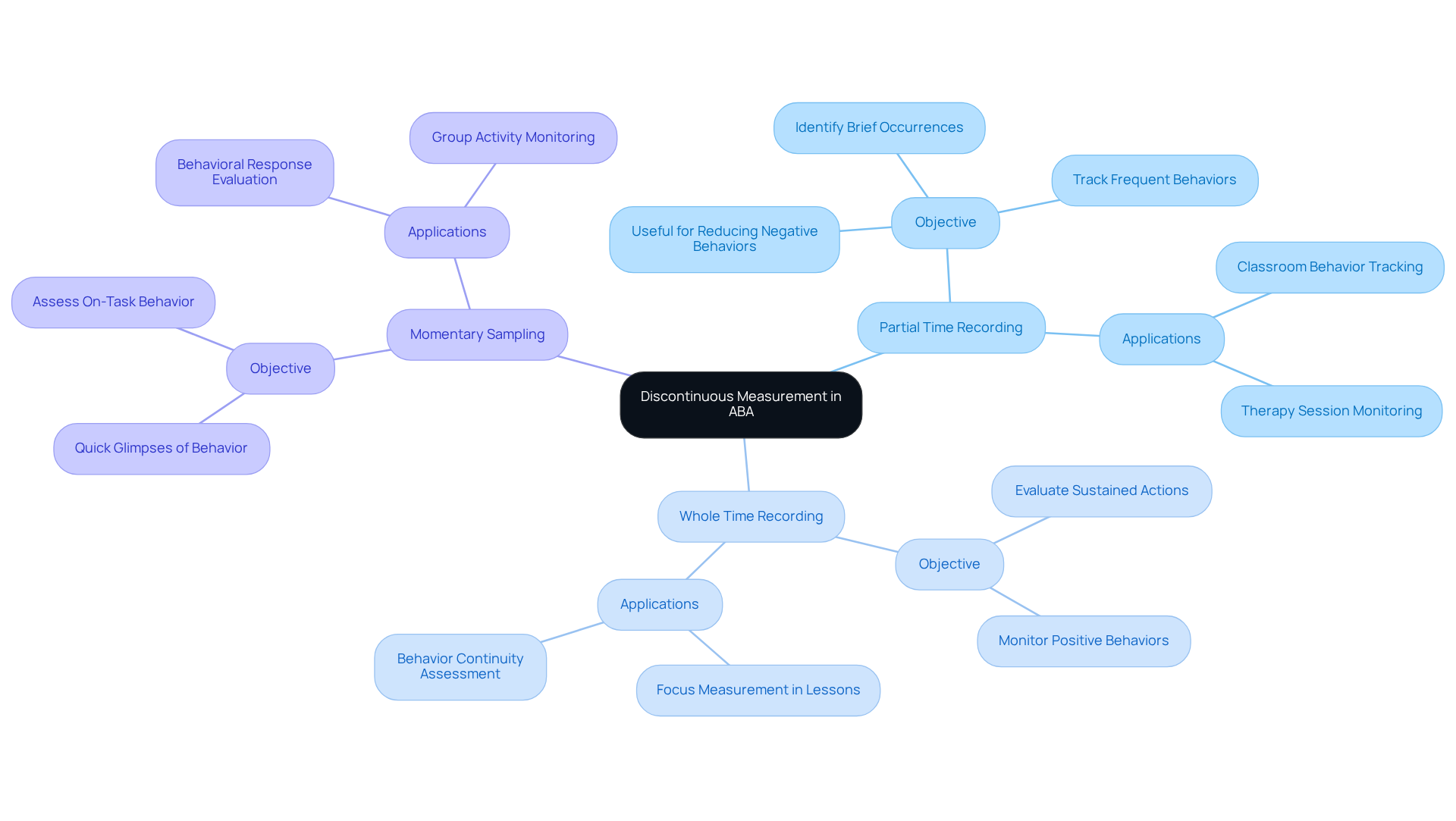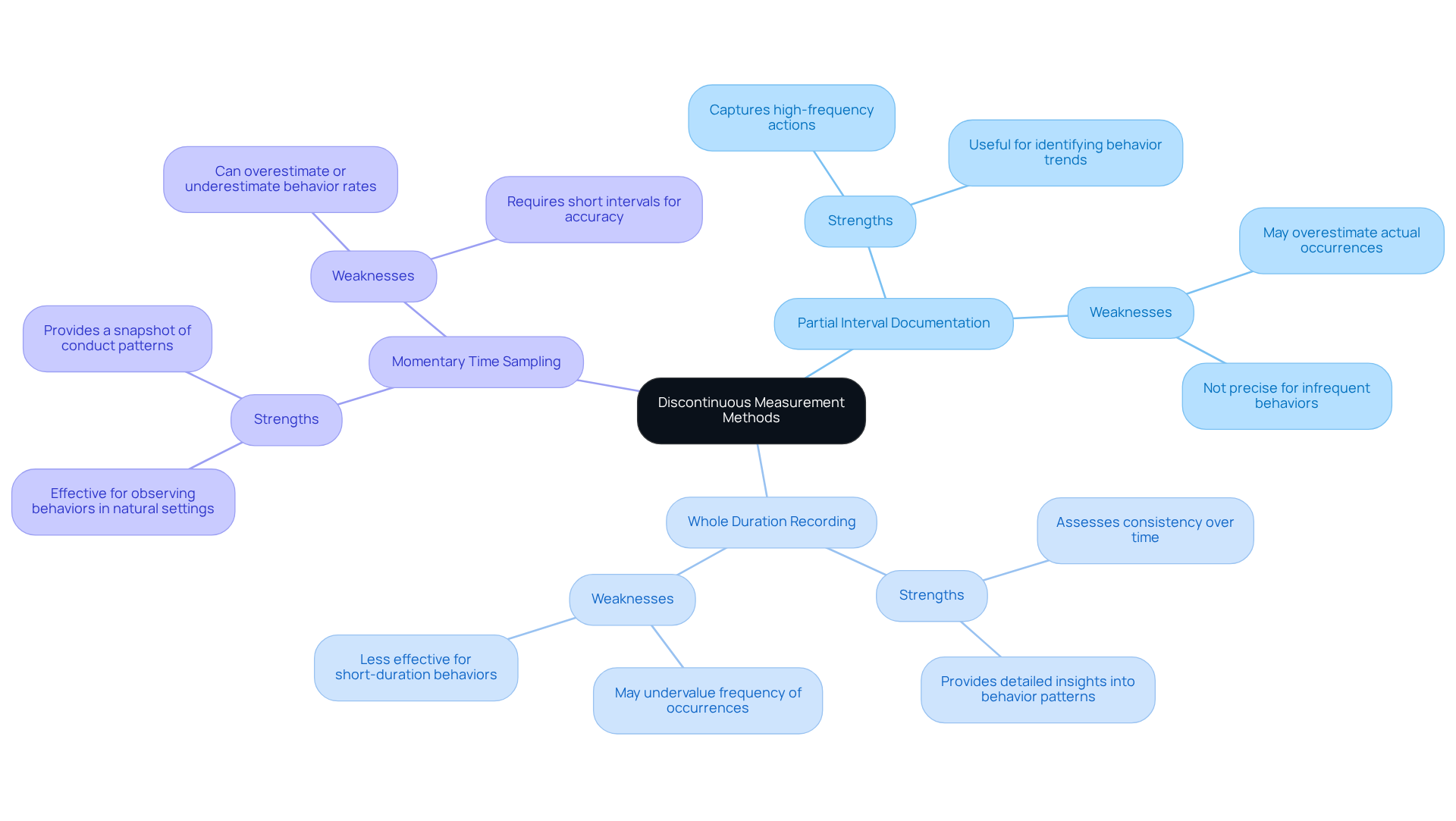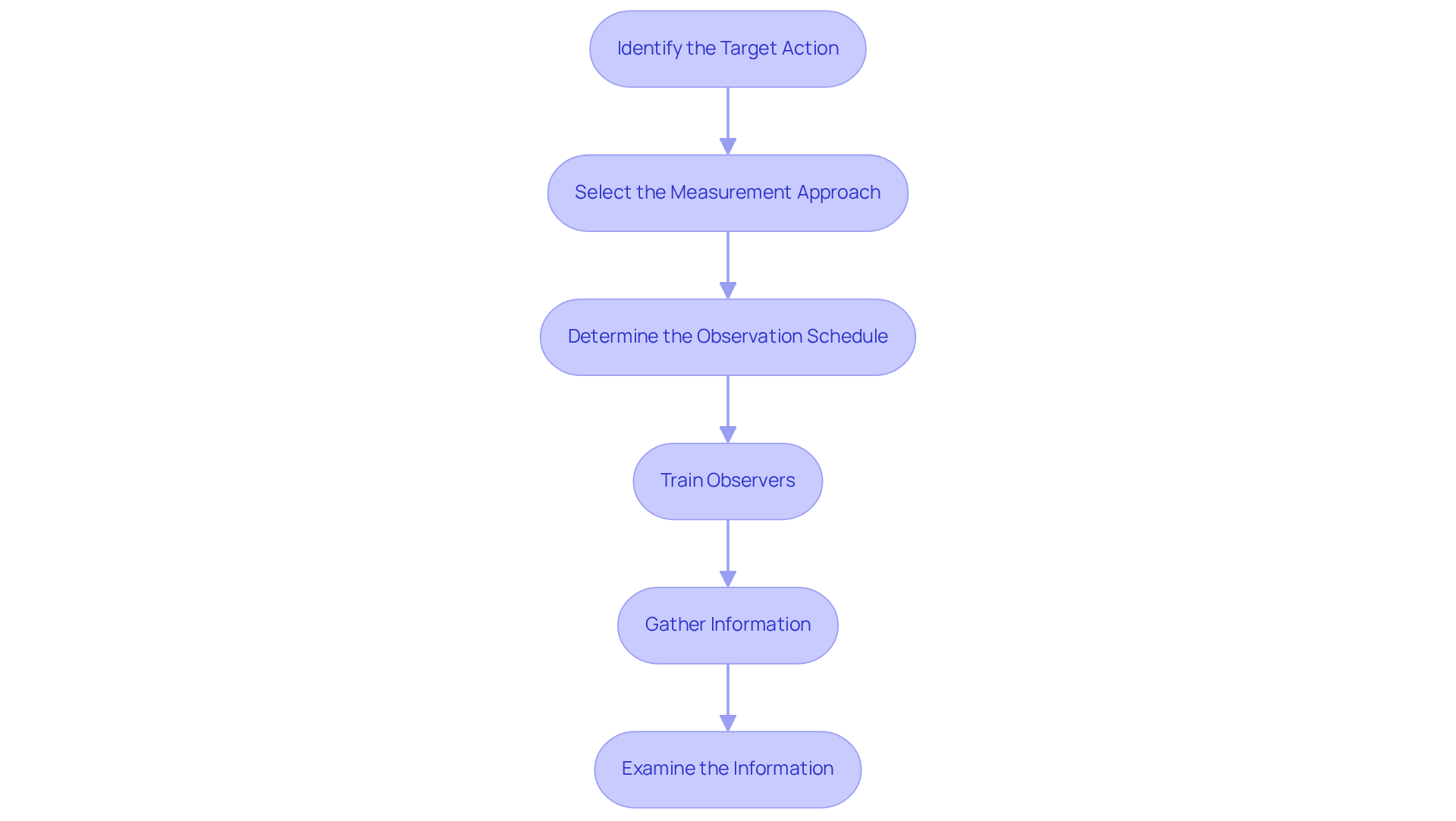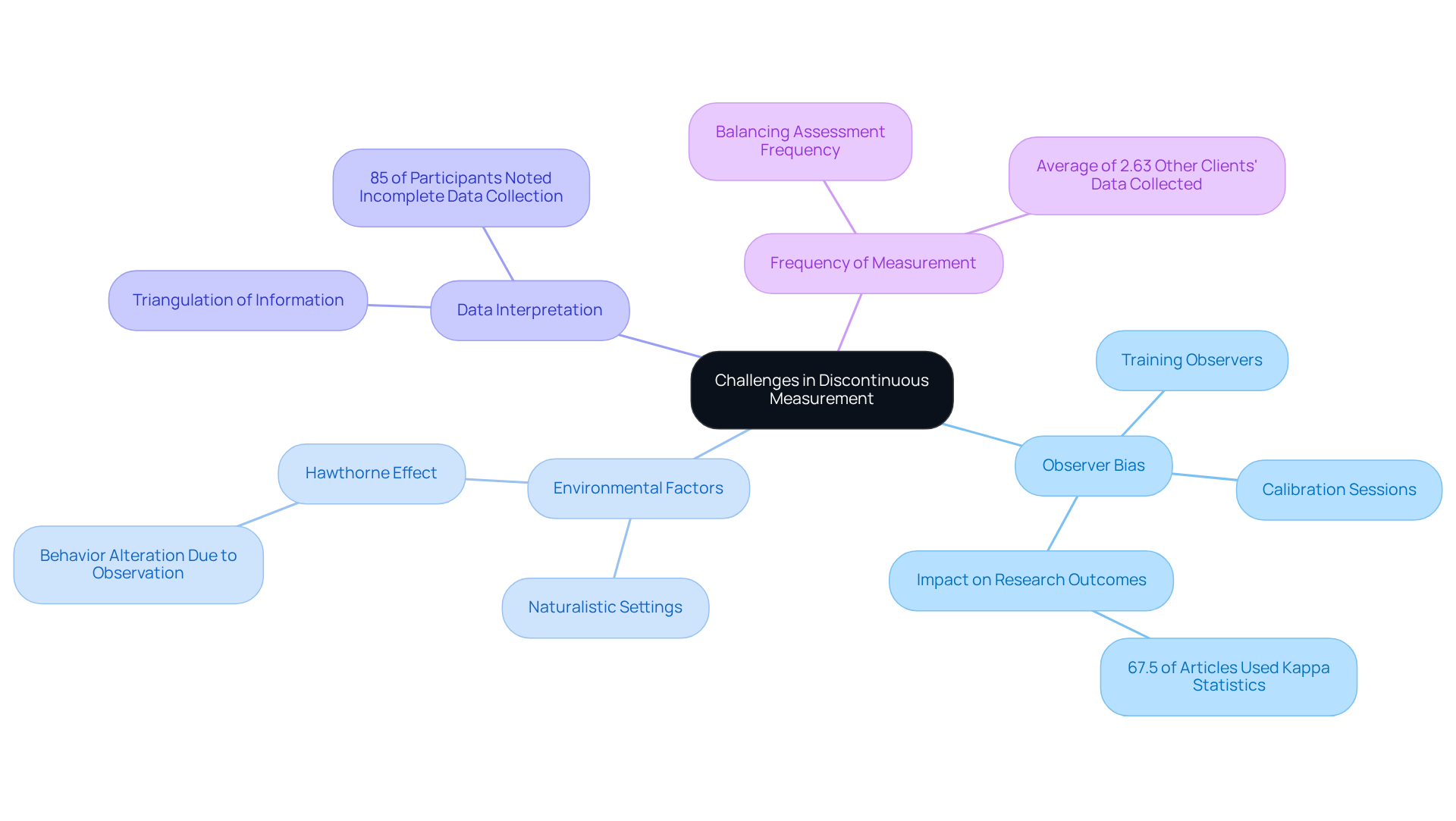September 25, 2025

This article presents a comprehensive guide for practitioners aiming to master discontinuous measurement techniques in Applied Behavior Analysis (ABA). It underscores the critical importance of methods such as:
Furthermore, it emphasizes the necessity of thorough observer training to mitigate challenges like observer bias and environmental factors. By enhancing data accuracy, practitioners can significantly improve client outcomes. Are you ready to elevate your practice and ensure the highest standards in data collection? This guide is your essential resource.
In the realm of Applied Behavior Analysis (ABA), the ability to measure behaviors accurately is paramount. Yet, many practitioners struggle with the nuances of data collection. Discontinuous measurement presents a strategic approach, enabling effective tracking of behaviors without the constraints of constant observation.
However, mastering this technique raises essential questions:
This guide delves into the intricacies of discontinuous measurement, equipping practitioners with the knowledge to enhance their assessment strategies and ultimately improve client outcomes.
In Applied Behavior Analysis (ABA), discontinuous measurement refers to data gathering techniques that capture occurrences at specific points instead of relying on constant observation. This method proves especially advantageous for monitoring rare actions or when ongoing assessment is impractical. The primary techniques of discontinuous measurement include:
Each approach serves distinct objectives:
Recent research underscores the impact of non-continuous measurement on analysis results, indicating that shorter durations consistently yield greater alignment with continuous data compared to longer durations. For instance, studies demonstrate that utilizing durations of two minutes or less significantly enhances the relationship between continuous and discontinuous measures. The effective application of these techniques is evident in various environments, such as classrooms, where partial interval recording is employed to track aggressive actions, enabling teachers to implement timely interventions.
The importance of discontinuous measurement in ABA therapy cannot be overstated, as it allows practitioners to gather valuable information without the burden of continuous observation. Current trends reveal an increasing reliance on electronic data collection tools, which reduce human error and facilitate data analysis, thereby enhancing the precision of monitoring activities. By mastering these techniques, Board Certified Behavior Analysts (BCBAs) can refine their evaluation and intervention strategies, ultimately leading to improved outcomes for clients.

There are three primary types of discontinuous measurement methods:
Partial Interval Documentation: This method involves noting whether an action occurred at any moment during a specified period. It effectively captures high-frequency actions; however, it may lead to an overestimation of actual occurrences.
Whole Duration Recording: In this approach, an action is documented only if it occurs throughout the entire duration. This technique is beneficial for assessing actions that require consistency over time, though it may undervalue the frequency of occurrences.
Momentary Time Sampling: This technique records whether an action is taking place at the end of each interval. It is particularly effective for observing behaviors in natural settings, providing a snapshot of conduct patterns without the need for continuous observation.
Each of these methods has unique strengths and weaknesses when it comes to discontinuous measurement. Therefore, the choice of technique should align closely with the specific goals of the assessment.

To implement discontinuous measurement effectively, adhere to the following steps:
Identify the Target Action: Clearly define the action you wish to measure, ensuring it is both observable and measurable.
Select the Measurement Approach: Choose the appropriate technique for discontinuous measurement based on the characteristics of the conduct and the assessment objectives. Common methods include Partial Interval Recording, Whole Interval Recording, and Momentary Time Sampling.
Determine the Observation Schedule: Establish observation periods tailored to the behavior's frequency and context. For instance, intervals of 30 seconds are recommended for Partial Interval Recording, while 60 seconds is advised for Whole Interval Recording to enhance accuracy.
Train Observers: Comprehensive training for all information gatherers is crucial for accurate discontinuous measurement. Research indicates that well-trained observers significantly enhance information accuracy, which is vital for reliable conduct analysis.
Gather Information: Initiate the observation process, meticulously documenting details according to the selected method. Ensure the environment is conducive to precise measurement, minimizing distractions that could influence actions.
Examine the Information: After collecting the information, analyze the results to identify patterns and trends in the behavior. Utilizing trial-by-trial information gathering enables monitoring changes in performance by charting the percentage of correct responses over time. This analysis is essential for informing intervention strategies and optimizing treatment plans based on individual progress.

When implementing discontinuous measurement, practitioners must navigate several key challenges effectively:
Observer Bias: It is crucial to train observers to minimize personal biases that can distort data collection. Regular calibration sessions are essential to ensure consistency and reliability in observations. Studies indicate that observer bias can significantly impact research outcomes; notably, 67.5% of reviewed articles employed kappa statistics or correlations to test inter-observer reliability. Therefore, it is vital to implement strategies that enhance objectivity.
Environmental Factors: The surroundings can greatly influence actions, making it essential to conduct observations in environments that reflect usual conditions. For instance, the Hawthorne effect—where individuals alter their behavior due to awareness of being observed—can skew results. To mitigate this effect, ensure that observations occur in naturalistic settings and are as inconspicuous as possible.
Data Interpretation: A complete picture of behavior may not be provided by discontinuous measurement. It is advantageous to utilize this approach alongside other measurement techniques for a more thorough analysis. This method allows for triangulation of information, enhancing the credibility of results and reducing the risk of observer bias. Significantly, 85% of participants noted that information gatherers occasionally do not complete collection tasks, underscoring the need for employing various techniques to ensure comprehensive analysis.
Frequency of Measurement: Establishing an appropriate frequency for information collection is critical. Infrequent assessments may overlook important behavioral shifts, while excessive observation can lead to observer fatigue, compromising the integrity of the data. Data collectors reported an average of 2.63 other clients' data to collect simultaneously, illustrating the practical challenges practitioners face in maintaining effective data collection. Balancing these factors is essential for effective monitoring.
By proactively addressing these challenges, practitioners can significantly enhance the effectiveness of their efforts in discontinuous measurement, leading to more accurate assessments and improved outcomes in ABA therapy.

Mastering discontinuous measurement in Applied Behavior Analysis (ABA) is essential for practitioners aiming to enhance their data collection methods. This approach allows for efficient tracking of behaviors without the need for constant observation, making it particularly useful in settings where continuous monitoring is impractical. By understanding and applying various techniques, such as:
professionals can gain critical insights into client behaviors.
The significance of each discontinuous measurement method is highlighted, detailing their unique advantages and potential drawbacks. It is crucial to select the appropriate technique based on the specific goals of the assessment and the nature of the behavior being observed. Furthermore, the challenges associated with discontinuous measurement—such as observer bias, environmental factors, and the frequency of data collection—are addressed, along with strategies to mitigate these issues for more reliable outcomes.
Ultimately, the effective implementation of discontinuous measurement can lead to improved assessment accuracy and better intervention strategies in ABA therapy. Practitioners are encouraged to embrace these techniques, continually refine their skills, and remain vigilant against common pitfalls. By doing so, they can ensure that their data collection practices not only inform treatment plans but also contribute to the overall success of their clients in achieving meaningful behavioral change.
What is discontinuous measurement in Applied Behavior Analysis (ABA)?
Discontinuous measurement in ABA refers to data gathering techniques that capture occurrences of behavior at specific points in time rather than through constant observation. It is particularly useful for monitoring rare actions or when ongoing assessment is impractical.
What are the primary techniques of discontinuous measurement?
The primary techniques of discontinuous measurement include partial time recording, whole time recording, and momentary sampling.
What is the purpose of partial duration recording?
Partial duration recording is used to effectively identify brief occurrences of actions.
How does whole duration recording function?
Whole duration recording evaluates sustained actions over a specified period.
What is momentary time sampling?
Momentary time sampling provides quick glimpses of actions at specific moments, allowing for a snapshot view of behavior.
How do shorter durations impact the relationship between continuous and discontinuous measures?
Research indicates that shorter durations, specifically two minutes or less, enhance the alignment between continuous and discontinuous data, leading to more accurate analysis results.
In what environments are these measurement techniques commonly applied?
These techniques are often applied in settings such as classrooms, where partial interval recording may be used to track aggressive behaviors, enabling timely interventions by teachers.
Why is discontinuous measurement important in ABA therapy?
Discontinuous measurement is important because it allows practitioners to gather valuable behavioral data without the need for constant observation, making it easier to track behaviors and implement interventions.
What trends are emerging in the use of discontinuous measurement?
Current trends show an increasing reliance on electronic data collection tools, which help reduce human error and facilitate data analysis, thereby improving the precision of monitoring activities.
How can mastering discontinuous measurement techniques benefit Board Certified Behavior Analysts (BCBAs)?
By mastering these techniques, BCBAs can refine their evaluation and intervention strategies, ultimately leading to improved outcomes for their clients.
Our expert recruitment strategies and AI-driven sourcing ensure that you receive top-notch candidates quickly, without compromising on quality. Whether you’re looking for BCBAs, Clinical Directors, or RBTs, we’ve got you covered.